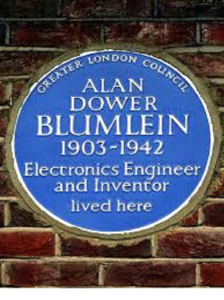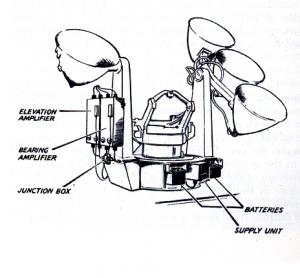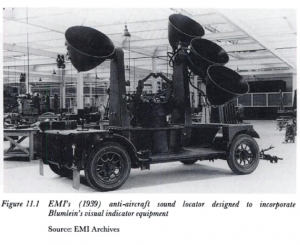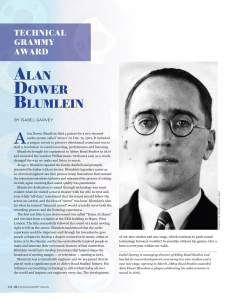Background
Alan Blumlein is given a posthumous Grammy award for his contribution to music recording. He also led the BBC team which successfully chose Marconi-EMI electronic 405-line transmission for the new television medium over the cumbersome mechanical alternative.
Ian Hillson
Looking back a couple of years, I see he got a plaque at Abbey Road:
(Click on the picture below to see a larger or clearer version of this picture:
Click the “X” button (top right) to close the newly opened picture.)
John Howell
He was a true genius, in 1938 he invented VIE: Visual Indicating Equipment. VIE used two microphones to listen for approaching aircraft and display their positions on a CRT. This then became the basis of the display for radar.
The VIE kit was a small transportable unit with one or two seats a bit like a gun turret and 3 Foot diameter reflectors.
(Click on the picture below to see a larger or clearer version of this picture:
Click the “X” button (top right) to close the newly opened picture.)
… and the two microphones? The 4021 apple and biscuit!
Keith Wicks
While reading about Blumlein, I came across this photograph of the VIE that resembles the diagram John Howell found.
(Click on the picture below to see a larger or clearer version of this picture:
Click the “X” button (top right) to close the newly opened picture.)
It comes from the book “The Life And Times Of A D Blumlein” by Russell Burns, published in 2000 by the IEE in association with the Science Museum.
Mike Minchin
I was given a folder of reproduction Blitz related documents, and one was a “cigarette card” which looks like the Blumlein A-A locator in use. Given the time of first publication perhaps not too surprising that the machine is obscured!
(Click on the picture below to see a larger or clearer version of this picture:
Click the “X” button (top right) to close the newly opened picture.)
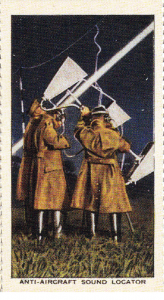
Pat Heigham
Perhaps enemy aircraft were shot (down) with early Dolby 3.1 ?
My Production Mixer, with whom I worked of two of the Bond movies, had worked on radar systems during WW2 – but he never said very much about it. Probably felt that the Official Secrets Act was still valid.
Dave Plowman
The BBC R4 news described Alan Blumlein as the man who invented stereo radio.
Ian Hillson
(Click on the picture below to see a larger or clearer version of this picture:
Click the “X” button (top right) to close the newly opened picture.)
Pat Heigham
I am a member of AMPS, (Association of Motion Picture Sound), a little similar to IPS, but AMPS is more oriented towards film – or hi-def electronic now, and does not encompass radio side of things.
A former Chairman, Bob Allen, a well respected Production Sound Mixer (“Day of the Jackal”) now sadly deceased, was highly interested in audio history, and I believe wrote up Alan Blumlein in our Journal. I’ll try and find the article.
He was always scathing about attempting to shoot stereophonic sound at source for films, preferring to let the stereo image be created in post-production – he called it ‘stereo-phoney’! The nature of discontinuous shooting makes keeping the b/g image even, almost impossible.
I’ve had a documentary experience for Yorkshire TV, which, when I spoke to them before shooting, wanted the audio in A/B stereo. I would have preferred To render M-S, and I would have been right, as the A/B was disaster, trying to cover a polo match at Smith’s lawn, Windsor, with fly-on-the wall interviews, right under the Heathrow flight path. Of course, the b/g atmos was all over the place! Better to have shot mono.
On another occasion, doing set-up interviews at the Roland Garros tennis venue in Paris, the Director went ape-shit when he saw me setting up a stereo mic beyond the I/V which I was intending to use to mix in stereo FX. The I/V mics were on radios. He said that the last time someone did that, at the mix down, one side of the audio disappeared! I knew immediately that the I/V personal mics had been out-of-phase with the stereo FX mic(s). He was unconvinced that I knew what I was doing, so I shot it mono. Later, I reproduced the set-up, deliberately putting the personals out-of-phase, and satisfactorily proved my suspicion.
Dave Plowman
Luckily, most of the directors I’ve worked with wouldn’t know a stereo mic from a mono one -especially inside a Rycote.
Chris Woolf
The use of A/B (or more accurately L/R) as a transport format really came about because there was less risk of confusion. Tracks could be mono-ed without a worry, and even just running a single track usually results in intelligible audio.
However, specifying L/R for transporting audio around the place never meant that it had to be acquired that way, or be processed in post-production in that format. MS mic arrays, with mixers that could translate the signals to L/R have always been available, and any sound desk can handle L/R signals as MS for the purpose of controlling image width. An engineering competence has always been needed to recognise the interchange of formats and use this concept properly.
The root problem – which is continued with surround sound – is the presumption that the same basic techniques used for mono recording can also be used for stereo. They can’t – stereo (and surround) horizons need to remain stable, so boom techniques have to be different, and personal mics can only ever be mono.
Most – not all – sound recordists are aware of this but few have the authority to tell a director to work appropriately, and none have the power over budgets to spend time making it happen..
Thus faked spacial audio becomes the norm, but it isn’t very satisfactory, and that hasn’t helped convince an audience to bother with spatial audio to any extent.
Nick Ware
Nowadays, I think I’m right in saying, no-one records dialogue in stereo, and with that in mind, AudioEase have recently released a version of Altiverb (“Indoor Acoustics for Post”) with a library of indoor room IRs, which makes stereo dialogue recording even more pointless. You can always pan mono dialogue if you feel the need to, then add the room. Much better than trying to do it at the shoot.
There’s an interesting article about Altiverb in this month’s “Resolution” magazine (February 2017), which explains why it’s often better now to record music erring on the dry side without ‘space’ mics, then use the nearest appropriate building acoustic, or even the actual building itself, from the ever-growing Altiverb IR library. That way you end up with a convincingly natural acoustic, but free from traffic noise, heating system noise, etc.
See: www.audioease.com
Pat’s second paragraph is puzzling, as the stereo fx mic would have to be exactly coincident with the personals for anything to cancel out altogether. At best, whatever their electrical phase relationship, all you would be aware of is a timing error between the two (correctable with delay on most current digital location mixers), and facing the stereo fx mics away from the personals helps minimise that too.
Pat Heigham
I’ve no idea how the previous stereo shoot was set up, the one that frightened the director. Perhaps the stereo FX mic was too close to interview mics – I don’t know. My later test set-up did mean that the stereo mic was in a position to pick-up the I/V mics, as I had suspected.
My rig would have worked, as the I/V mics were very foreground, and the stereo FX mic was positioned well beyond, and backed off to the personals. As the director was panicking, and obviously knew f-all about sound, I did it his way for peace.
As I said, the earlier shoot must have had the I/V mics out of phase, and the FX mic too close.
John Howell
Before procedures for handling stereo were finalised at TV Centre all manner of mishaps occurred, many concerning the contents of the 2 audio tracks available from VT.
Everything was fine if the progress of a tape was well documented and intentions were clear, but every now and then, as studio Sound Sup., I would be offered a VT that was obviously M + S, or Commentary on A and FX on B, or Mono on A and occasional layed off bits used during the edit on B, or, in the case of News, sync on A and Voice Over on B. In those early days there was no magic MS-AB button anywhere on the sound desk.
As regards robustness, the S signal was generally lower level than the M and, if noisy, affected stereo imaging.
We owe a lot to Ray Angel and Brian Hiles (TVC Sound Supervisors) for sorting out these types of problems in the early days at TVC.
Dave Mundy
Oh, for the simple days of mono! On the OB sports unit doing single-camera coverage of a football match I used an SQN4 to feed our two channel Betacam camcorder. I put commentary plus FX one track 1, and CFX (mix-minus) on track 2, using a clever bit of pluggery using one of the standard guitar isolation transformers (M&F XLR each end!) to power the 816 from one end and mix it with the comm. Mixed on headphones standing on the gantry in freezing weather – what a great life! Never had a complaint from VT! Simples!
Graeme Wall
Betacam: were you using the 50 or the much heavier 110?
Dave Mundy
Betacam SP: would it be a 507? With removable head etc. as used on the bobsleigh in Lillehammer, very quick pan!


